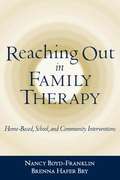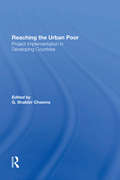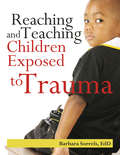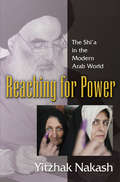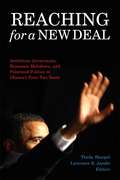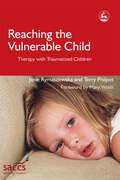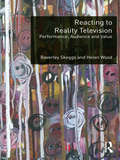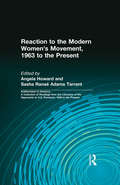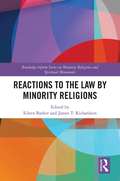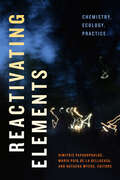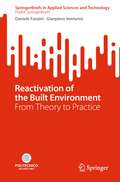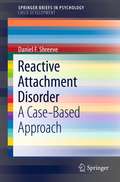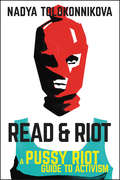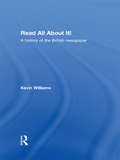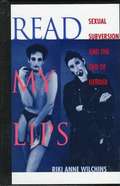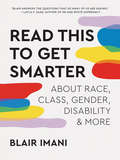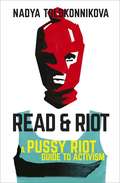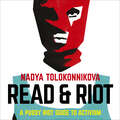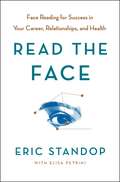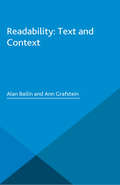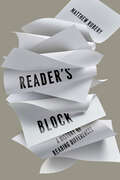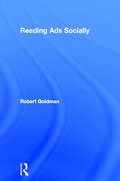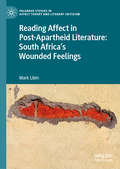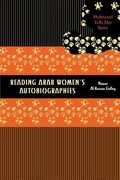- Table View
- List View
Reaching Out in Family Therapy
by Nancy Boyd-Franklin Nancy Hafer BryThis volume provides the skills practitioners need to conduct family therapy sessions in the home, school, and community. The authors demonstrate how meetings outside of the traditional office setting can enable therapists to intervene actively in the various systems that affect clients' lives. This multisystems approach can be particularly useful when working with poor and ethnic minority families, whose support networks may include extended family, school personnel, and members of the "church family." Practitioners learn how to utilize out-of-office sessions to meet the people who are influential in clients' lives; observe the life realities of children, adolescents, and parents; and identify resources that can be mobilized to produce change. Detailed strategies are presented to help families navigate the overlapping demands of multiple agencies and institutions and to manage and prevent such problems as substance abuse, school drop-out, and child abuse. Throughout, therapeutic and ethical guidelines are illustrated by extensive clinical case material. The book is ideal for those already doing home-based work, as well as those who would like to incorporate it into their practice.
Reaching The Urban Poor: Project Implementation In Developing Countries
by G. Shabbir Cheema G Shabbir CheemaAs urban populatiCC'lS in developing countries oootinue to grow rapidly, cne of the nest critical issues in the Third W:lrld has beoane p:rovidirYJ shelter and other basic services such as clean water, heal th clinics, and sewage disposal to the urban poor. This book of nine case studies of urban programs and projects in Ind:oesia, Kenya, Malaysia, Nigeria, Pakistan, South Korea, India, and Sri Lanka focuses en impediments to slum upgrading. The authour discuss each project's evoluticn, the capabilities and resources of inplenenting agencies, the problems of interagency relaticoships and coordinaticn, costs and funding, the difficulties of developing effective linkages with poor cx:mnunities, and the accessibility of the new services to the urban poor.
Reaching and Teaching Children Exposed to Trauma
by Barbara SorrelsWhat does a harmed child look like? It's the little girl on the playground who has mysterious bruises on her legs. It's the three-month-old baby boy who arches his back when you try to hold him. It's the four-year-old who bites and hits when asked to clean up. These are the faces of traumatized children. As an early childhood professional, you play a key role in the early identification of maltreatment and unhealthy patterns of development. You are also the gateway to healing. In Reaching and Teaching Children Exposed to Trauma, you will find the tools and strategies to connect with harmed children and start them on the path to healing.
Reaching for Power: The Shi'a in the Modern Arab World
by Yitzhak NakashAs the world focuses on the conflict in Iraq, the most important political players in that country today are not the Sunni insurgents. Instead, they are Iraq's Shi'I majority--part of the Middle East's ninety million Shi'I Muslims who hold the key to the future of the region and the relations between Muslim and Western societies. So contends Yitzhak Nakash, one of the world's foremost experts on Shi'ism. With his characteristic verve and style, Nakash traces the role of the Shi'is in the struggle that is raging today among Muslims for the soul of Islam. He shows that in contrast to the growing militancy among Sunni groups since the 1990s, Shi'is have shifted their focus from confrontation to accommodation with the West. Constituting sixty percent of the population of Iraq, they stand squarely at the center of the U.S government's attempt to remake the Middle East and bring democracy to the region. This groundbreaking book addresses the crucial importance of Shi'is to the U.S. endeavor. Yet it also alerts readers to the strong nationalist sentiments of Shi'is, underscoring the difficult challenge that the United States faces in attempting to impose a new order in the Middle East. The book provides a comprehensive historical perspective on Shi'ism, beginning with the emergence of the movement during the seventh century, continuing through its rise as a political force since the Iranian Islamic Revolution of 1978-79, and leading up to the Iraqi elections of January 2005. Drawing extensively on Arabic sources, this comparative study highlights the reciprocal influences shaping the political development of Shi'is in Iraq, Saudi Arabia, Bahrain, and Lebanon, as well as the impact of the revival of Shi'ism on the larger Arab world. The narrative concludes with an assessment of the risks and possibilities arising from the assertion of Shi'I power in Iraq and from America's attempt to play an increasingly forceful role in the Middle East. A landmark book and a work of remarkable scholarship, Reaching for Power illuminates the Shi'a resurgence amid the shifting geopolitics of the Middle East.
Reaching for a New Deal: Ambitious Governance, Economic Meltdown, and Polarized Politics in Obama's First Two Years
by Lawrence R. Jacobs Theda SkocpolDuring his winning presidential campaign, Barack Obama promised to counter rising economic inequality and revitalize America’s middle-class through a series of wide-ranging reforms. His transformational agenda sought to ensure affordable healthcare; reform the nation’s schools and make college more affordable; promote clean and renewable energy; reform labor laws and immigration; and redistribute the tax burden from the middle class to wealthier citizens. The Wall Street crisis and economic downturn that erupted as Obama took office also put U.S. financial regulation on the agenda. By the middle of President Obama’s first term in office, he had succeeded in advancing major reforms by legislative and administrative means. But a sluggish economic recovery from the deep recession of 2009, accompanied by polarized politics and governmental deadlock in Washington, DC, have raised questions about how far Obama’s promised transformations can go. Reaching for a New Deal analyzes both the ambitious domestic policy of Obama’s first two years and the consequent political backlash—up to and including the 2010 midterm elections. Reaching for a New Deal opens by assessing how the Obama administration overcame intense partisan struggles to achieve legislative victories in three areas—health care reform, federal higher education loans and grants, and financial regulation. Lawrence Jacobs and Theda Skocpol examine the landmark health care bill, signed into law in spring 2010, which extended affordable health benefits to millions of uninsured Americans after nearly 100 years of failed legislative attempts to do so. Suzanne Mettler explains how Obama succeeded in reorienting higher education policy by shifting loan administration from lenders to the federal government and extending generous tax tuition credits. Reaching for a New Deal also examines the domains in which Obama has used administrative action to further reforms in schools and labor law. The book concludes with examinations of three areas—energy, immigration, and taxes—where Obama’s efforts at legislative compromises made little headway. Reaching for a New Deal combines probing analyses of Obama’s domestic policy achievements with a big picture look at his change-oriented presidency. The book uses struggles over policy changes as a window into the larger dynamics of American politics and situates the current political era in relation to earlier pivotal junctures in U.S. government and public policy. It offers invaluable lessons about unfolding political transformations in the United States.
Reaching the Vulnerable Child: Therapy with Traumatized Children
by Terry Philpot Mary WalshTherapy is a critical element of work with abused children, offering them the opportunity to explore past experiences in a safe environment with the emotional support of a therapist. Reaching the Vulnerable Child offers a tried-and-tested model of integrated therapy that incorporates play and expressive arts to foster verbal, non-verbal and symbolic communication. The authors describe how emotional, physical and sexual abuse impact on children's development, and discuss attachment, separation, loss, and the effects of trauma on brain functioning. They provide practical guidance on preparing for sessions and creating safe therapeutic environments, and explain the importance of involving carers in the recovery process. Drawing on a wide range of techniques including play, movement, art, drama, music and therapeutic story work, this approach proposes methods for addressing guilt and low self-esteem, establishing trust and dealing with sexualized or aggressive behaviour. This guide to working with abused children and young people will be valued by professionals and therapists from a range of backgrounds, including psychotherapists, play therapists and arts therapists, as well as those responsible for children's services. It is an ideal accompaniment to The Child's Own Story, also in the Delivering Recovery series.
Reacting to Reality Television: Performance, Audience and Value
by Beverley Skeggs Helen WoodThe unremitting explosion of reality television across the schedules has become a sustainable global phenomenon generating considerable popular and political fervour. The zeal with which television executives seize on the easily replicated formats is matched equally by the eagerness of audiences to offer themselves up as television participants for others to watch and criticise. But how do we react to so many people breaking down, fronting up, tearing apart, dominating, empathising, humiliating, and seemingly laying bare their raw emotion for our entertainment? Do we feel sad when others are sad? Or are we relieved by the knowledge that our circumstances might be better? As reality television extends into the experiences of the everyday, it makes dramatic and often shocking the mundane aspects of our intimate relations, inviting us as viewers into a volatile arena of mediated morality. This book addresses the impact of this endless opening out of intimacy as an entertainment trend that erodes the traditional boundaries between spectator and performer demanding new tools for capturing television’s relationships with audiences. Rather than asking how the reality television genre is interpreted as ‘text’ or representation the authors investigate the politics of viewer encounters as interventions, evocations, and more generally mediated social relations. The authors show how different reactions can involve viewers in tournaments of value, as women viewers empathise and struggle to validate their own lives. The authors use these detailed responses to challenge theories of the self, governmentality and ideology. A must read for both students and researchers in audience studies, television studies and media and communication studies.
Reaction to the Modern Women's Movement, 1963 to the Present (Antifeminism In America: A Collection Of Readings From The Literature Of The Opponents To U. S. Feminism, 1848 To The Present Ser. #3)
by Angela Howard Sasha Ranaé Adams TarrantAntifeminism in cultural context To give today's readers an understanding of the social and political forces that actively fought against any changes in women's status in the United States, the editors selected these original examples from the writings of the time that appeared in popular books and magazines. Opponents of women's equality frequently voiced their opinions about 19th-century issues of women's suffrage, dress reform, self-expression, independence, and other topics that touched upon the perceived roles and duties of women. Such public diatribes continued into the 10th century as determined antifeminists argued against increased opportunities for women in employment and education, denied the propriety of family planning, and admonished against women's involvement in politics. Arguments based on ridicule, natural law, and false claims Some opponents merely dismissed or ridiculed calls for changes in women's status, without specifying particular flaws in the feminist position. Others cited divine ordination, applied to natural law, and fanned public fears of familial and social disintegration. Frequently these critics resorted to charges of presumed lesbianism, communism, and socialism against advocates of women's rights and against the movement itself. This adamant opposition to equality for women was a manifestation of common apprehension about ongoing social, economic, and political changes beyond antifeminist control. Antifeminists in their own words Today few people have even an inkling of the vehemence, theatrical posturing, and convoluted reasoning of the antifeminist forces. This varied selection of original sources puts an illuminating spotlight on the arguments presented by opponents of women's equality that is drawn from an extensive body of writings, ranging from the elegant pronouncements of a popular politician to sincere endorsements of the status quo by female apologists for those opposed to the women's movement, to purveyors of low satire in the popular press. For modern readers, this collection provides the opportunity to encounter directly the reasoning, opinions, and perceptions of those that resisted and criticized the goals and achievements of feminism. A valuable resource for many disciplines. A particularly valuable feature of this set is its wealth of primary source material from the 19th and early 20th centuries, including material from books and newspapers. Very few libraries have collected these sources and chances are no single collection has them all. These volumes are of great interest to women's studies, women's history, gender studies, cultural studies, as well as history, political science, sociology, and literature. Many of the examples of antifeminist writing found in the set can enrich classroom discussions and assignments that involve communication, writing, and rhetoric. Available individually by volume 1. Opposition to the Women's Movement in the United States, 1848-1929 (0-8153-2713-7) 400 pages 2. Redefining the New Woman, 1920-1963 (0-8153-2714-5) 344 pages 3. Reaction to the Modern Women's Movement, 1963 to the Present (0-8153-2715-3) 352 pages
Reactions To the Law by Minority Religions (Routledge Inform Series on Minority Religions and Spiritual Movements)
by Eileen Barker and James T. RichardsonMuch has been written about the law as it affects new and minority religions, but relatively little has been written about how such religions react to the law. This book presents a wide variety of responses by minority religions to the legal environments within which they find themselves. An international panel of experts offer examples from North America, Europe and Asia demonstrating how religions with relatively little status may resort to violence or passive acceptance of the law; how they may change their beliefs or practices in order to be in compliance with the law; or how they may resort to the law itself in order to change their legal standing, sometimes by forging alliances with those with more power or authority to achieve their goals. The volume concludes by applying theoretical insights from sociological studies of law, religion and social movements to the variety of responses. The first systematic collection focussing on how minority religions respond to efforts at social control by various governmental agents, this book provides a vital reference for scholars of religion and the law, new religious movements, minority religions and the sociology of religion.
Reactivating Elements: Chemistry, Ecology, Practice (Elements)
by Dimitris Papadopoulos, Maria Puig De La Bellacasa, & Natasha MyersThe contributors to Reactivating Elements examine chemicals as they mix with soil, air, water, and fire to shape Earth's troubled ecologies today. They invoke the elements with all their ambivalences as chemical categories, material substances, social forms, forces and energies, cosmological entities, and epistemic objects. Engaging with the nonlinear historical significance of elemental thought across fields—chemistry, the biosciences, engineering, physics, science and technology studies, the environmental humanities, ecocriticism, and cultural studies—the contributors examine the relationship between chemistry and ecology, probe the logics that render wind as energy, excavate affective histories of ubiquitous substances such as plastics and radioactive elements, and chart the damage wrought by petrochemical industrialization. Throughout, the volume illuminates how elements become entangled with power and control, coloniality, racism, and extractive productivism while exploring alternative paths to environmental destruction. In so doing, it rethinks the relationship between the elements and the elemental, human and more-than-human worlds, today’s damaged ecosystems and other ecologies to come.Contributors. Patrick Bresnihan, Tim Choy, Joseph Dumit, Cori Hayden, Stefan Helmreich, Joseph Masco, Michelle Murphy, Natasha Myers, Dimitris Papadopoulos, María Puig de la Bellacasa, Astrid Schrader, Isabelle Stengers
Reactivation of the Built Environment: From Theory to Practice (SpringerBriefs in Applied Sciences and Technology)
by Daniele Fanzini Gianpiero VenturiniThe book deals with urban reactivation, a particular form of regeneration intervention which in addition to the physical-spatial dimension of the places also—and above all—considers the social and relational dynamics that the intervention is able to activate. In this sense, the concept of activation (or reactivation) emphasizes the act of putting something into or back into operation, whether it concerns the material components of a container (a building or a place) or the immaterial components of a content (a need, or a function), starting from the exploitation of opportunities that the architectural project contributes to revealing, developing and accompanying.
Reactive Attachment Disorder
by Daniel F. ShreeveA child's close bond with mother, father, or guardian usually provides a foundation for trust in all future attachments. Children deprived of early and healthy dependency--who do not form normal attachment with their caregivers--may later suffer from Reactive Attachment Disorder (RAD). This childhood disorder is characterized by a general failure in social relationships resulting from pathogenic care. Although first included in the third edition of the Diagnostic and Statistical Manual (DSM-III) in 1980, RAD is one of the more uncommon and understudied forms of psychopathology. Reactive Attachment Disorder: A Case-Based Approach adds to a now growing research base, providing scholars and clinicians with a well-rounded analysis of RAD and suggested treatments. The case-based approach used in this Brief follows the representative case of "Jorge," presented as unfolding over time and structured to illustrate challenges of diagnosis, to show examples of co-morbidity, and to provoke reflection on what questions may arise during treatment. Readers are asked to appraise the overlap with other clinical syndromes, the forms of psychotherapy which may apply, and the potential role of psychiatric medications as part of a comprehensive treatment plan.
Read & Riot: A Pussy Riot Guide to Activism
by Nadya TolokonnikovaFrom artist, activist, and Pussy Riot founder Nadya Tolokonnikova, a guerilla guide to radical protest and joyful political resistanceThe face of modern protest is wearing a brightly colored ski mask. Nadya Tolokonnikova, founding member of the Russian activist group Pussy Riot, is a creative activist, professional protestor, brazen feminist, shocking visual artist, and force to be reckoned with. Her spontaneous, explosive approach to political action has involved jumping over barbed wire, kissing police officers, giving guerilla performances in crowded subway cars, and going on a hunger strike to protest the abuse of prisoners. She’s been horse-whipped by police in Sochi, temporarily blinded when officers threw green paint in her eyes, and monitored by the Russian government. But what made Nadya an activist icon overnight happened on February 21, 2012, when she was arrested for performing an anti-Putin protest song in a Moscow church. She was sent to a Russian prison for 18 months and emerged as an international symbol of radical resistance, as calls to “Free Pussy Riot” resounded around the world. With her emblematic ski mask, black lipstick, and unwavering bravery, Nadya has become an emissary of hope and optimism despite overwhelming and ugly political corruption. Read & Riot is structured around Nadya’s ten rules for revolution (Be a pirate! Make your government shit its pants! Take back the joy!) and illustrated throughout with stunning examples from her extraordinary life and the philosophies of other revolutionary rebels throughout history. Rooted in action and going beyond the typical “call your senator” guidelines, Read & Riot gives us a refreshing model for civil disobedience, and encourages our right to question every status quo and make political action exciting—even joyful.
Read All About It!: A History of the British Newspaper
by Kevin WilliamsThis Text-book traces the evolution of the newspaper, documenting its changing form, style and content as well as identifying the different roles ascribed to it by audiences, government and other social institutions. Starting with the early 17th century, when the first prototype newspapers emerged, through Dr Johnson, the growth of the radical press in the early 19th century, the Lord Northcliffe revolution in the early 20th century, the newspapers wars of the 1930s and the rise of the tabloid in the 1970s, right up to Rupert Murdoch and the online revolution, the book explores the impact of the newspapers on our lives and its role in British society. Using lively and entertaining examples, Kevin Williams illustrates the changing form of the newspaper in its social, political, economic and cultural context. As well as telling the story of the newspaper, he explores key topics in detail, making this an ideal text for students of journalism and the British newspaper. Issues include: newspapers and social change the changing face of regional newspapers the impact of new technology development of reporting techniques forms of press regulation
Read My Lips: Sexual Subversion and the End of Gender
by Riki WilchinsWilchins is a well-known activist in the transgender community. This book is partly autobiographical, partly gender studies and politics. She writes with humor and a witty style. The book enters the Bookshare collection 11 years after being published and is still completely current the issues raised. There is a section of photographs of political actions, many uncaptioned, which were not included in the finished scan. Page numbers were picked up after this section. Wilchins uses slang words for genitals and some sections are sexually explicit, could be considered erotic.
Read This to Get Smarter: about Race, Class, Gender, Disability & More
by Blair ImaniAn approachable guide to being an informed, compassionate, and socially conscious person today—from discussions of race, gender, and sexual orientation to disability, class, and beyond—from critically acclaimed historian, educator, and author Blair Imani.&“Blair answers the questions that so many of us are asking.&”—Layla F. Saad, author of Me and White SupremacyWe live in a time where it has never been more important to be knowledgeable about a host of social issues, and to be confident and appropriate in how to talk about them. What&’s the best way to ask someone what their pronouns are? How do you talk about racism with someone who doesn&’t seem to get it? What is intersectionality, and why do you need to understand it? While it can seem intimidating or overwhelming to learn and talk about such issues, it&’s never been easier thanks to educator and historian Blair Imani, creator of the viral sensation Smarter in Seconds videos.Accessible to learners of all levels—from those just getting started on the journey to those already versed in social justice—Read This to Get Smarter covers a range of topics, including race, gender, class, disability, relationships, family, power dynamics, oppression, and beyond. This essential guide is a radical but warm and non-judgmental call to arms, structured in such a way that you can read it cover to cover or start with any topic you want to learn more about.With Blair Imani as your teacher, you&’ll &“get smarter&” in no time, and be equipped to intelligently and empathetically process, discuss, and educate others on the crucial issues we must tackle to achieve a liberated, equitable world.
Read and Riot: A Pussy Riot Guide to Activism
by Nadya Tolokonnikova"as indispensable to confronting, say, your domineering mother-in-law or your local city council as it is to helping foment an ongoing and ever-escalating insurrection against, say, a sexist, racist, nepotistic power-mad oligarchy threatening to destroy democracy as we know it...My advice: Buy one" - VOGUEA guerrilla guide to radical protest and joyful political resistance from artist, activist and Pussy Riot founder Nadya Tolokonnikova. The face of modern protest is wearing a brightly colored ski mask.Nadya Tolokonnikova, founding member of the Russian activist group Pussy Riot, is a creative activist, professional protestor, brazen feminist, shocking visual artist, and force to be reckoned with. Her spontaneous, explosive approach to political action has involved jumping over barbed wire, kissing police officers, giving guerilla performances in crowded subway cars, and going on a hunger strike to protest the abuse of prisoners. She's been horse-whipped by police in Sochi, temporarily blinded when officers threw green paint in her eyes, and monitored by the Russian government. But what made Nadya an activist icon overnight happened on February 21, 2012, when she was arrested for performing an anti-Putin protest song in a Moscow church.She was sent to a Russian prison for 18 months and emerged as an international symbol of radical resistance, as calls to "Free Pussy Riot" resounded around the world. With her emblematic ski mask, black lipstick, and unwavering bravery, Nadya has become an emissary of hope and optimism despite overwhelming and ugly political corruption.Read & Riot is structured around Nadya's ten rules for revolution (Be a pirate! Make your government shit its pants! Take back the joy!) and illustrated throughout with stunning examples from her extraordinary life and the philosophies of other revolutionary rebels throughout history. Rooted in action and going beyond the typical "call your senator" guidelines, Read & Riot gives us a refreshing model for civil disobedience, and encourages our right to question every status quo and make political action exciting--even joyful.
Read and Riot: A Pussy Riot Guide to Activism
by Nadya Tolokonnikova"Stylish, striking, and elegantly packaged...as indispensible to confronting, say, your domineering mother-in-law or your local city council as it is to helping foment an ongoing and ever-escalating insurrection against, say, a sexist, racist, nepotistic power-mad oligarchy threatening to destory democracy as we know it...My advice: Buy one" - VOGUEFrom artist, activist, and Pussy Riot founder Nadya Tolokonnikova, a guerilla guide to radical protest and joyful political resistanceThe face of modern protest is wearing a brightly colored ski mask.Nadya Tolokonnikova, founding member of the Russian activist group Pussy Riot, is a creative activist, professional protestor, brazen feminist, shocking visual artist, and force to be reckoned with. Her spontaneous, explosive approach to political action has involved jumping over barbed wire, kissing police officers, giving guerilla performances in crowded subway cars, and going on a hunger strike to protest the abuse of prisoners. She's been horse-whipped by police in Sochi, temporarily blinded when officers threw green paint in her eyes, and monitored by the Russian government. But what made Nadya an activist icon overnight happened on February 21, 2012, when she was arrested for performing an anti-Putin protest song in a Moscow church.She was sent to a Russian prison for 18 months and emerged as an international symbol of radical resistance, as calls to "Free Pussy Riot" resounded around the world. With her emblematic ski mask, black lipstick, and unwavering bravery, Nadya has become an emissary of hope and optimism despite overwhelming and ugly political corruption.Read & Riot is structured around Nadya's ten rules for revolution (Be a pirate! Make your government shit its pants! Take back the joy!) and illustrated throughout with stunning examples from her extraordinary life and the philosophies of other revolutionary rebels throughout history. Rooted in action and going beyond the typical "call your senator" guidelines, Read & Riot gives us a refreshing model for civil disobedience, and encourages our right to question every status quo and make political action exciting--even joyful.(P)2019 Hodder & Stoughton Limited
Read in the Name of Your Lord: Islamic Literacy Development in Revolutionary Egypt (Public Cultures of the Middle East and North Africa)
by Nermeen MouftahEgypt's January 2011 uprising spurred millions to action with a cacophony of demands—including the call to address Egypt's education crisis and adult literacy rates. Read in the Name of Your Lord traces the push for universal literacy as a project caught between revolutionary activism and Islamic reformism in post-Mubarak Egypt. Despite their many disagreements, religious reformers, revolutionaries, and state actors converged on literacy as the first step toward realizing aspirations of the revolution. They invoked the verse Muslims believe was the first to be revealed, "Read in the name of your Lord," to teach literacy as a religious duty and the foundation for the country's future. Nermeen Mouftah unravels how this religiously inspired push for universal literacy was born of twenty-first-century scripturalism and simultaneously went beyond the Quran, to make reading and writing virtuous acts of the liberal state. While revolutionary literacy campaigns soon vanished and adult literacy rates remained stubbornly low, their efforts revealed the importance of recognizing alternative modes of text processing and the personhood and knowledge of nonliterate people. Read in the Name of Your Lord demonstrates how the rise in modern scripturalism underpinned literacy activism, blurring the binary between secular and religious knowledge.
Read the Face: Face Reading for Success in Your Career, Relationships, and Health
by Elisa Petrini Eric StandopRelearn the intuitive language of face reading From birth, face is our first language. We are born face readers—knowing to seek out human features and faces from the moment our eyes open. We all have the intuitive ability to read and interpret the feelings and expressions of those around us. In Read the Face, master face reader Eric Standop unlocks the power of this innate human ability, sharing his own journey to become a face reading master, along with stories that illustrate the power of this unique language. Using a combination of three different schools of face reading, along with a scientific accuracy to detect the most fleeting microexpressions, Standop is able to read personality, character, emotions, and even the state of a person’s health—all from simply glancing at their face. The book is divided into sections focusing on specific ways that face reading can offer insight, such as Health, Love, Communication, Work and Success. The stories are accompanied by detailed black and white illustrations of faces, allowing readers to observe the same features that Standop interpreted. The final section of the book outlines the meanings of dozens of facial features and face shapes, so that readers can recognize their own innate intuitive powers and develop them. Read the Face is a guide to using the ancient art and science of face reading to go beyond the surface and create the boldest life possible.
Readability: Text and Context
by Alan Bailin Ann GrafsteinThis book explores what makes a book readable by bringing together the relevant literature and theories, and situating them within a unified account. It provides a single resource that offers a principled discussion of the issues and their applications.
Reader's Block: A History of Reading Differences
by Matthew RuberyWhat does the term "reading" mean? Matthew Rubery's exploration of the influence neurodivergence has on the ways individuals read asks us to consider that there may be no one definition. This alternative history of reading tells the stories of "atypical" readers and the impact had on their lives by neurological conditions affecting their ability to make sense of the printed word: from dyslexia, hyperlexia, and alexia to synesthesia, hallucinations, and dementia. Rubery's focus on neurodiversity aims to transform our understanding of the very concept of reading. Drawing on personal testimonies gathered from literature, film, life writing, social media, medical case studies, and other sources to express how cognitive differences have shaped people's experiences both on and off the page, Rubery contends that there is no single activity known as reading. Instead, there are multiple ways of reading (and, for that matter, not reading) despite the ease with which we use the term. Pushing us to rethink what it means to read, Reader's Block moves toward an understanding of reading as a spectrum that is capacious enough to accommodate the full range of activities documented in this fascinating and highly original book. Read it from cover to cover, out of sequence, or piecemeal. Read it upside down, sideways, or in a mirror. For just as there is no right way to read, there is no right way to read this book. What matters is that you are doing something with it—something that Rubery proposes should be called "reading."
Reading Ads Socially
by Robert GoldmanThis systematic and authoritative book provides an unrivalled guide to understanding ad culture. It shows how the logic of commodities permeates the ways we think about ourselves, our relationships and our desires. Richly illustrated and written with great clarity, it will be essential reading for anyone interested in ad culture.
Reading Affect in Post-Apartheid Literature: South Africa's Wounded Feelings (Palgrave Studies in Affect Theory and Literary Criticism)
by Mark LibinThis book examines South Africa’s post-apartheid culture through the lens of affect theory in order to argue that the socio-political project of the “new” South Africa, best exemplified in their Truth and Reconciliation Commission Hearings, was fundamentally an affective, emotional project. Through the TRC hearings, which publicly broadcast the testimonies of both victims and perpetrators of gross human rights violations, the African National Congress government of South Africa, represented by Nelson Mandela and Archbishop Desmond Tutu, endeavoured to generate powerful emotions of contrition and sympathy in order to build an empathetic bond between white and black citizens, a bond referred to frequently by Tutu in terms of the African philosophy of interconnection: ubuntu. This book explores the representations of affect, and the challenges of generating ubuntu, through close readings of a variety of cultural products: novels, poetry, memoir, drama, documentary film and audio anthology.
Reading Arab Women's Autobiographies: Shahrazad Tells Her Story
by Nawar Al-Hassan GolleyAuthors of autobiographies are always engaged in creating a "self" to present to their readers. This process of self-creation raises a number of intriguing questions: why and how does anyone choose to present herself or himself in an autobiography? Do women and men represent themselves in different ways and, if so, why? How do differences in culture affect the writing of autobiography in various parts of the world?
